Landslide Susceptibility Mapping Based on the Germinal Center Optimization Algorithm and Support Vector Classification
Abstract
1. Introduction
2. Methods
2.1. Study Area
2.1.1. Description of the Study Area
2.1.2. Landslide Inventory
2.1.3. Influencing Factors
2.2. Preparation of the Training and Test Datasets
2.3. Analysis of the Factors Influencing Landslides
2.4. Landslide Susceptibility Models
2.4.1. GCO-SVC
- (1)
- SVC
- (2)
- GCO
- (3)
- Implementation of the GCO-SVC model
2.4.2. Models for Comparison
- (1)
- ANN
- (2)
- DT
- (3)
- KNN
- (4)
- RF
- (5)
- GRID-SVC
- (6)
- GA-SVC
2.5. Model Evaluation Criteria
3. Results
3.1. Influencing Factor Analysis
3.2. Optimal Hyperparameters
3.3. Model Performance Comparison
3.4. Landslide Susceptibility Maps
4. Discussion
4.1. PFI of the Influencing Factors
4.2. Sensitivity Analysis of the Parameters of the GCO-SVC Model
5. Conclusions
Author Contributions
Funding
Data Availability Statement
Conflicts of Interest
References
- Tang, H.; Wasowski, J.; Juang, C.H. Geohazards in the three Gorges Reservoir Area, China—Lessons learned from decades of research. Eng. Geol. 2019, 261, 105267. [Google Scholar] [CrossRef]
- Haque, U.; da Silva, P.F.; Devoli, G.; Pilz, J.; Zhao, B.; Khaloua, A.; Wilopo, W.; Andersen, P.; Lu, P.; Lee, J.; et al. The human cost of global warming: Deadly landslides and their triggers (1995–2014). Sci. Total Environ. 2019, 682, 673–684. [Google Scholar] [CrossRef]
- Zêzere, J.L.; Ferreira, A.B.; Rodrigues, M.L. Landslides in the North of Lisbon Region (Portugal): Conditioning and triggering factors. Phys. Chem. Earth Part A Solid Earth Geod. 1999, 24, 925–934. [Google Scholar] [CrossRef]
- Jebur, M.N.; Pradhan, B.; Tehrany, M.S. Optimization of landslide conditioning factors using very high-resolution airborne laser scanning (LiDAR) data at catchment scale. Remote Sens. Environ. 2014, 152, 150–165. [Google Scholar] [CrossRef]
- Wang, Y.; Fang, Z.; Hong, H. Comparison of convolutional neural networks for landslide susceptibility mapping in Yanshan County, China. Sci. Total Environ. 2019, 666, 975–993. [Google Scholar] [CrossRef] [PubMed]
- Sezer, E.A.; Pradhan, B.; Gokceoglu, C. Manifestation of an adaptive neuro-fuzzy model on landslide susceptibility mapping: Klang valley, Malaysia. Expert Syst. Appl. 2011, 38, 8208–8219. [Google Scholar] [CrossRef]
- Kalantar, B.; Pradhan, B.; Naghibi, S.A.; Motevalli, A.; Mansor, S. Assessment of the effects of training data selection on the landslide susceptibility mapping: A comparison between support vector machine (SVM), logistic regression (LR) and artificial neural networks (ANN). Geomat. Nat. Hazards Risk 2017, 9, 49–69. [Google Scholar] [CrossRef]
- Choi, J.; Oh, H.-J.; Lee, H.-J.; Lee, C.; Lee, S. Combining landslide susceptibility maps obtained from frequency ratio, logistic regression, and artificial neural network models using ASTER images and GIS. Eng. Geol. 2012, 124, 12–23. [Google Scholar] [CrossRef]
- Wang, H.B.; Li, J.M.; Zhou, B.; Zhou, Y.; Yuan, Z.Q.; Chen, Y.P. Application of a hybrid model of neural networks and genetic algorithms to evaluate landslide susceptibility. Geoenviron. Disasters 2017, 4, 15. [Google Scholar] [CrossRef][Green Version]
- Adnan, M.S.G.; Rahman, M.S.; Ahmed, N.; Ahmed, B.; Rabbi, M.F.; Rahman, R.M. Improving Spatial Agreement in Machine Learning-Based Landslide Susceptibility Mapping. Remote Sens. 2020, 12, 3347. [Google Scholar] [CrossRef]
- Zhou, X.; Wen, H.; Zhang, Y.; Xu, J.; Zhang, W. Landslide susceptibility mapping using hybrid random forest with GeoDetector and RFE for factor optimization. Geosci. Front. 2021, 12, 101211. [Google Scholar] [CrossRef]
- Sameen, M.I.; Pradhan, B.; Bui, D.T.; Alamri, A.M. Systematic sample subdividing strategy for training landslide susceptibility models. CATENA 2020, 187, 104358. [Google Scholar] [CrossRef]
- Marjanović, M.; Kovačević, M.; Bajat, B.; Voženílek, V. Landslide susceptibility assessment using SVM machine learning algorithm. Eng. Geol. 2011, 123, 225–234. [Google Scholar] [CrossRef]
- Yalcin, A.; Reis, S.; Aydinoglu, A.C.; Yomralioglu, T. A GIS-based comparative study of frequency ratio, analytical hierarchy process, bivariate statistics and logistics regression methods for landslide susceptibility mapping in Trabzon, NE Turkey. CATENA 2011, 85, 274–287. [Google Scholar] [CrossRef]
- Avand, M.; Janizadeh, S.; Naghibi, S.A.; Pourghasemi, H.R.; Khosrobeigi Bozchaloei, S.; Blaschke, T. A Comparative Assessment of Random Forest and k-Nearest Neighbor Classifiers for Gully Erosion Susceptibility Mapping. Water 2019, 11, 2076. [Google Scholar] [CrossRef]
- Rabby, Y.W.; Hossain, M.B.; Abedin, J. Landslide susceptibility mapping in three Upazilas of Rangamati hill district Bangladesh: Application and comparison of GIS-based machine learning methods. Geocarto Int. 2021. [Google Scholar] [CrossRef]
- Huang, F.; Yin, K.; Huang, J.; Gui, L.; Wang, P. Landslide susceptibility mapping based on self-organizing-map network and extreme learning machine. Eng. Geol. 2017, 223, 11–22. [Google Scholar] [CrossRef]
- Zhou, C.; Yin, K.; Cao, Y.; Ahmed, B.; Li, Y.; Catani, F.; Pourghasemi, H.R. Landslide susceptibility modeling applying machine learning methods: A case study from Longju in the Three Gorges Reservoir area, China. Comput. Geosci. 2018, 112, 23–37. [Google Scholar] [CrossRef]
- Hong, H.; Liu, J.; Zhu, A.X. Modeling landslide susceptibility using LogitBoost alternating decision trees and forest by penalizing attributes with the bagging ensemble. Sci. Total Environ. 2020, 718, 137231. [Google Scholar] [CrossRef] [PubMed]
- Sun, D.; Xu, J.; Wen, H.; Wang, D. Assessment of landslide susceptibility mapping based on Bayesian hyperparameter optimization: A comparison between logistic regression and random forest. Eng. Geol. 2021, 281, 105972. [Google Scholar] [CrossRef]
- Sun, D.; Wen, H.; Wang, D.; Xu, J. A random forest model of landslide susceptibility mapping based on hyperparameter optimization using Bayes algorithm. Geomorphology 2020, 362, 107201. [Google Scholar] [CrossRef]
- Ma, J.; Wang, Y.; Niu, X.; Jiang, S.; Liu, Z. A comparative study of mutual information-based input variable selection strategies for the displacement prediction of seepage-driven landslides using optimized support vector regression. Stoch. Environ. Res. Risk Assess. 2022. [Google Scholar] [CrossRef]
- Zhang, J.; Tang, H.; Tannant, D.D.; Lin, C.; Xia, D.; Liu, X.; Zhang, Y.; Ma, J. Combined forecasting model with CEEMD-LCSS reconstruction and the ABC-SVR method for landslide displacement prediction. J. Clean. Prod. 2021, 293, 126205. [Google Scholar] [CrossRef]
- Merghadi, A.; Yunus, A.P.; Dou, J.; Whiteley, J.; ThaiPham, B.; Bui, D.T.; Avtar, R.; Abderrahmane, B. Machine learning methods for landslide susceptibility studies: A comparative overview of algorithm performance. Earth-Sci. Rev. 2020, 207, 103225. [Google Scholar] [CrossRef]
- Niu, R.; Wu, X.; Yao, D.; Peng, L.; Ai, L.; Peng, J. Susceptibility Assessment of Landslides Triggered by the Lushan Earthquake, April 20, 2013, China. IEEE J. Sel. Top. Appl. Earth Obs. Remote Sens. 2014, 7, 3979–3992. [Google Scholar] [CrossRef]
- Chen, Y.-R.; Chen, J.-W.; Hsieh, S.-C.; Ni, P.-N. The Application of Remote Sensing Technology to the Interpretation of Land Use for Rainfall-Induced Landslides Based on Genetic Algorithms and Artificial Neural Networks. IEEE J. Sel. Top. Appl. Earth Obs. Remote Sens. 2009, 2, 87–95. [Google Scholar] [CrossRef]
- Moayedi, H.; Mehrabi, M.; Mosallanezhad, M.; Rashid, A.S.A.; Pradhan, B. Modification of landslide susceptibility mapping using optimized PSO-ANN technique. Eng. Comput. 2019, 35, 967–984. [Google Scholar] [CrossRef]
- Wang, J.; Su, A.; Xiang, W.; Yeh, H.-F.; Xiong, C.; Zou, Z.; Zhong, C.; Liu, Q. New data and interpretations of the shallow and deep deformation of Huangtupo No. 1 riverside sliding mass during seasonal rainfall and water level fluctuation. Landslides 2016, 13, 795–804. [Google Scholar] [CrossRef]
- Su, X.; Tang, H.; Huang, L.; Shen, P.; Xia, D. The role of pH in red-stratum mudstone disintegration in the Three Gorges reservoir area, China, and the associated micromechanisms. Eng. Geol. 2020, 279, 105873. [Google Scholar] [CrossRef]
- Hungr, O.; Fell, R.; Couture, R.; Eberhardt, E. Landslide Risk Management; CRC Press: Boca Raton, FL, USA, 2005. [Google Scholar]
- Tang, M.; Xu, Q.; Yang, H.; Li, S.; Iqbal, J.; Fu, X.; Huang, X.; Cheng, W. Activity law and hydraulics mechanism of landslides with different sliding surface and permeability in the Three Gorges Reservoir Area, China. Eng. Geol. 2019, 260, 105212. [Google Scholar] [CrossRef]
- Hua, Y.; Wang, X.; Li, Y.; Xu, P.; Xia, W. Dynamic development of landslide susceptibility based on slope unit and deep neural networks. Landslides 2020, 18, 281–302. [Google Scholar] [CrossRef]
- Hu, X.; Huang, C.; Mei, H.; Zhang, H. Landslide susceptibility mapping using an ensemble model of Bagging scheme and random subspace–based naïve Bayes tree in Zigui County of the Three Gorges Reservoir Area, China. Bull. Eng. Geol. Environ. 2021, 80, 5315–5329. [Google Scholar] [CrossRef]
- Petschko, H.; Brenning, A.; Bell, R.; Goetz, J.; Glade, T. Assessing the quality of landslide susceptibility maps—Case study Lower Austria. Nat. Hazards Earth Syst. Sci. 2014, 14, 95–118. [Google Scholar] [CrossRef]
- Goetz, J.N.; Brenning, A.; Petschko, H.; Leopold, P. Evaluating machine learning and statistical prediction techniques for landslide susceptibility modeling. Comput. Geosci. 2015, 81, 1–11. [Google Scholar] [CrossRef]
- Chen, T.; Niu, R.; Du, B.; Wang, Y. Landslide spatial susceptibility mapping by using GIS and remote sensing techniques: A case study in Zigui County, the Three Georges reservoir, China. Environ. Earth Sci. 2015, 73, 5571–5583. [Google Scholar] [CrossRef]
- Gong, P.; Liu, H.; Zhang, M.; Li, C.; Wang, J.; Huang, H.; Clinton, N.; Ji, L.; Li, W.; Bai, Y.; et al. Stable classification with limited sample: Transferring a 30-m resolution sample set collected in 2015 to mapping 10-m resolution global land cover in 2017. Sci. Bull. 2019, 64, 370–373. [Google Scholar] [CrossRef]
- Tien Bui, D.; Tuan, T.A.; Klempe, H.; Pradhan, B.; Revhaug, I. Spatial prediction models for shallow landslide hazards: A comparative assessment of the efficacy of support vector machines, artificial neural networks, kernel logistic regression, and logistic model tree. Landslides 2016, 13, 361–378. [Google Scholar] [CrossRef]
- Fang, Z.; Wang, Y.; Niu, R.; Peng, L. Landslide Susceptibility Prediction Based on Positive Unlabeled Learning Coupled with Adaptive Sampling. IEEE J. Sel. Top. Appl. Earth Obs. Remote Sens. 2021, 14, 11581–11592. [Google Scholar] [CrossRef]
- Zhang, K.; Wu, X.; Niu, R.; Yang, K.; Zhao, L. The assessment of landslide susceptibility mapping using random forest and decision tree methods in the Three Gorges Reservoir area, China. Environ. Earth Sci. 2017, 76, 405. [Google Scholar] [CrossRef]
- Lai, J.S.; Tsai, F. Improving GIS-based Landslide Susceptibility Assessments with Multi-temporal Remote Sensing and Machine Learning. Sensors 2019, 19, 3717. [Google Scholar] [CrossRef] [PubMed]
- Sameen, M.I.; Pradhan, B.; Lee, S. Application of convolutional neural networks featuring Bayesian optimization for landslide susceptibility assessment. CATENA 2020, 186, 104249. [Google Scholar] [CrossRef]
- Chen, W.; Yan, X.; Zhao, Z.; Hong, H.; Bui, D.T.; Pradhan, B. Spatial prediction of landslide susceptibility using data mining-based kernel logistic regression, naive Bayes and RBFNetwork models for the Long County area (China). Bull. Eng. Geol. Environ. 2018, 78, 247–266. [Google Scholar] [CrossRef]
- Dormann, C.F.; Elith, J.; Bacher, S.; Buchmann, C.; Carl, G.; Carré, G.; Marquéz, J.R.G.; Gruber, B.; Lafourcade, B.; Leitão, P.J.; et al. Collinearity: A review of methods to deal with it and a simulation study evaluating their performance. Ecography 2012, 36, 27–46. [Google Scholar] [CrossRef]
- Zhao, L.; Wu, X.; Niu, R.; Wang, Y.; Zhang, K. Using the rotation and random forest models of ensemble learning to predict landslide susceptibility. Geomat. Nat. Hazards Risk 2020, 11, 1542–1564. [Google Scholar] [CrossRef]
- Dou, J.; Yunus, A.P.; Merghadi, A.; Wang, X.-k.; Yamagishi, H. A Comparative Study of Deep Learning and Conventional Neural Network for Evaluating Landslide Susceptibility Using Landslide Initiation Zones. In Understanding and Reducing Landslide Disaster Risk; Springer International Publishing: Cham, Switzerland, 2020; pp. 215–223. [Google Scholar] [CrossRef]
- Costanzo, D.; Rotigliano, E.; Irigaray, C.; Jiménez-Perálvarez, J.D.; Chacón, J. Factors selection in landslide susceptibility modelling on large scale following the gis matrix method: Application to the river Beiro basin (Spain). Nat. Hazards Earth Syst. Sci. 2012, 12, 327–340. [Google Scholar] [CrossRef]
- Li, W.; Fang, Z.; Wang, Y. Stacking ensemble of deep learning methods for landslide susceptibility mapping in the Three Gorges Reservoir area, China. Stoch. Environ. Res. Risk Assess. 2021. [Google Scholar] [CrossRef]
- Chen, W.; Zhao, X.; Shahabi, H.; Shirzadi, A.; Khosravi, K.; Chai, H.; Zhang, S.; Zhang, L.; Ma, J.; Chen, Y.; et al. Spatial prediction of landslide susceptibility by combining evidential belief function, logistic regression and logistic model tree. Geocarto Int. 2019, 34, 1177–1201. [Google Scholar] [CrossRef]
- Chang, Z.; Du, Z.; Zhang, F.; Huang, F.; Chen, J.; Li, W.; Guo, Z. Landslide Susceptibility Prediction Based on Remote Sensing Images and GIS: Comparisons of Supervised and Unsupervised Machine Learning Models. Remote Sens. 2020, 12, 502. [Google Scholar] [CrossRef]
- Ding, S.; Zhu, Z.; Zhang, X. An overview on semi-supervised support vector machine. Neural Comput. Appl. 2015, 28, 969–978. [Google Scholar] [CrossRef]
- Behzad, M.; Asghari, K.; Eazi, M.; Palhang, M. Generalization performance of support vector machines and neural networks in runoff modeling. Expert Syst. Appl. 2009, 36, 7624–7629. [Google Scholar] [CrossRef]
- Ma, J.; Niu, X.; Tang, H.; Wang, Y.; Wen, T.; Zhang, J. Displacement Prediction of a Complex Landslide in the Three Gorges Reservoir Area (China) Using a Hybrid Computational Intelligence Approach. Complexity 2020, 2020, 2624547. [Google Scholar] [CrossRef]
- Peng, L.; Niu, R.; Huang, B.; Wu, X.; Zhao, Y.; Ye, R. Landslide susceptibility mapping based on rough set theory and support vector machines: A case of the Three Gorges area, China. Geomorphology 2014, 204, 287–301. [Google Scholar] [CrossRef]
- Pourghasemi, H.R.; Jirandeh, A.G.; Pradhan, B.; Xu, C.; Gokceoglu, C. Landslide susceptibility mapping using support vector machine and GIS at the Golestan Province, Iran. J. Earth Syst. Sci. 2013, 122, 349–369. [Google Scholar] [CrossRef]
- Chen, W.; Pourghasemi, H.R.; Naghibi, S.A. A comparative study of landslide susceptibility maps produced using support vector machine with different kernel functions and entropy data mining models in China. Bull. Eng. Geol. Environ. 2018, 77, 647–664. [Google Scholar] [CrossRef]
- Dou, J.; Yunus, A.P.; Tien Bui, D.; Sahana, M.; Chen, C.-W.; Zhu, Z.; Wang, W.; Pham, B.T. Evaluating GIS-Based Multiple Statistical Models and Data Mining for Earthquake and Rainfall-Induced Landslide Susceptibility Using the LiDAR DEM. Remote Sens. 2019, 11, 638. [Google Scholar] [CrossRef]
- Su, C.; Wang, L.; Wang, X.; Huang, Z.; Zhang, X. Mapping of rainfall-induced landslide susceptibility in Wencheng, China, using support vector machine. Nat. Hazards 2015, 76, 1759–1779. [Google Scholar] [CrossRef]
- Villaseñor, C.; Arana-Daniel, N.; Alanis, A.Y.; Lopez-Franco, C.; Valencia-Murillo, R. Tracking of Non-rigid Motion in 3D Medical Imaging with Ellipsoidal Mapping and Germinal Center Optimization. In Hybrid Intelligent Systems in Control, Pattern Recognition and Medicine; Springer International Publishing: Cham, Switzerland, 2019; pp. 241–256. [Google Scholar] [CrossRef]
- Villaseñor, C.; Arana-Daniel, N.; Alanis, A.Y.; López-Franco, C.; Hernandez-Vargas, E.A. Germinal Center Optimization Algorithm. Int. J. Comput. Intell. Syst. 2018, 12, 13–27. [Google Scholar] [CrossRef]
- Yu, C.; Chen, J. Landslide Susceptibility Mapping Using the Slope Unit for Southeastern Helong City, Jilin Province, China: A Comparison of ANN and SVM. Symmetry 2020, 12, 1047. [Google Scholar] [CrossRef]
- Azarafza, M.; Azarafza, M.; Akgün, H.; Atkinson, P.M.; Derakhshani, R. Deep learning-based landslide susceptibility mapping. Sci. Rep. 2021, 11, 24112. [Google Scholar] [CrossRef]
- Hong, H.; Liu, J.; Bui, D.T.; Pradhan, B.; Acharya, T.D.; Pham, B.T.; Zhu, A.X.; Chen, W.; Ahmad, B.B. Landslide susceptibility mapping using J48 Decision Tree with AdaBoost, Bagging and Rotation Forest ensembles in the Guangchang area (China). CATENA 2018, 163, 399–413. [Google Scholar] [CrossRef]
- Khedr, A.E.; Idrees, A.M.; El Seddawy, A.I. Enhancing Iterative Dichotomiser 3 algorithm for classification decision tree. Wiley Interdiscip. Rev. Data Min. Knowl. Discov. 2016, 6, 70–79. [Google Scholar] [CrossRef]
- Tanyu, B.F.; Abbaspour, A.; Alimohammadlou, Y.; Tecuci, G. Landslide susceptibility analyses using Random Forest, C4.5, and C5.0 with balanced and unbalanced datasets. CATENA 2021, 203, 105355. [Google Scholar] [CrossRef]
- Guo, Z.; Shi, Y.; Huang, F.; Fan, X.; Huang, J. Landslide susceptibility zonation method based on C5.0 decision tree and K-means cluster algorithms to improve the efficiency of risk management. Geosci. Front. 2021, 12, 101249. [Google Scholar] [CrossRef]
- Chen, W.; Xie, X.; Wang, J.; Pradhan, B.; Hong, H.; Bui, D.T.; Duan, Z.; Ma, J. A comparative study of logistic model tree, random forest, and classification and regression tree models for spatial prediction of landslide susceptibility. CATENA 2017, 151, 147–160. [Google Scholar] [CrossRef]
- Pourghasemi, H.R.; Rahmati, O. Prediction of the landslide susceptibility: Which algorithm, which precision? CATENA 2018, 162, 177–192. [Google Scholar] [CrossRef]
- Souza, R.; Lotufo, R.; Rittner, L. A Comparison between Optimum-Path Forest and k-Nearest Neighbors Classifiers. In Proceedings of the 2012 25th SIBGRAPI Conference on Graphics, Patterns and Images, Ouro Preto, Brazil, 22–25 August 2012; pp. 260–267. [Google Scholar] [CrossRef]
- Mezaal, M.R.; Pradhan, B.; Rizeei, H.M. Improving Landslide Detection from Airborne Laser Scanning Data Using Optimized Dempster–Shafer. Remote Sens. 2018, 10, 1029. [Google Scholar] [CrossRef]
- Liu, R.; Li, L.; Pirasteh, S.; Lai, Z.; Yang, X.; Shahabi, H. The performance quality of LR, SVM, and RF for earthquake-induced landslides susceptibility mapping incorporating remote sensing imagery. Arab. J. Geosci. 2021, 14, 259. [Google Scholar] [CrossRef]
- Mandal, K.; Saha, S.; Mandal, S. Applying deep learning and benchmark machine learning algorithms for landslide susceptibility modelling in Rorachu river basin of Sikkim Himalaya, India. Geosci. Front. 2021, 12, 101203. [Google Scholar] [CrossRef]
- Kavzoglu, T.; Kutlug Sahin, E.; Colkesen, I. Selecting optimal conditioning factors in shallow translational landslide susceptibility mapping using genetic algorithm. Eng. Geol. 2015, 192, 101–112. [Google Scholar] [CrossRef]
- Breiman, L. Random Forests. Mach. Learn. 2001, 45, 5–32. [Google Scholar] [CrossRef]
- Saha, S.; Sarkar, R.; Roy, J.; Hembram, T.K.; Acharya, S.; Thapa, G.; Drukpa, D. Measuring landslide vulnerability status of Chukha, Bhutan using deep learning algorithms. Sci. Rep. 2021, 11, 16374. [Google Scholar] [CrossRef] [PubMed]
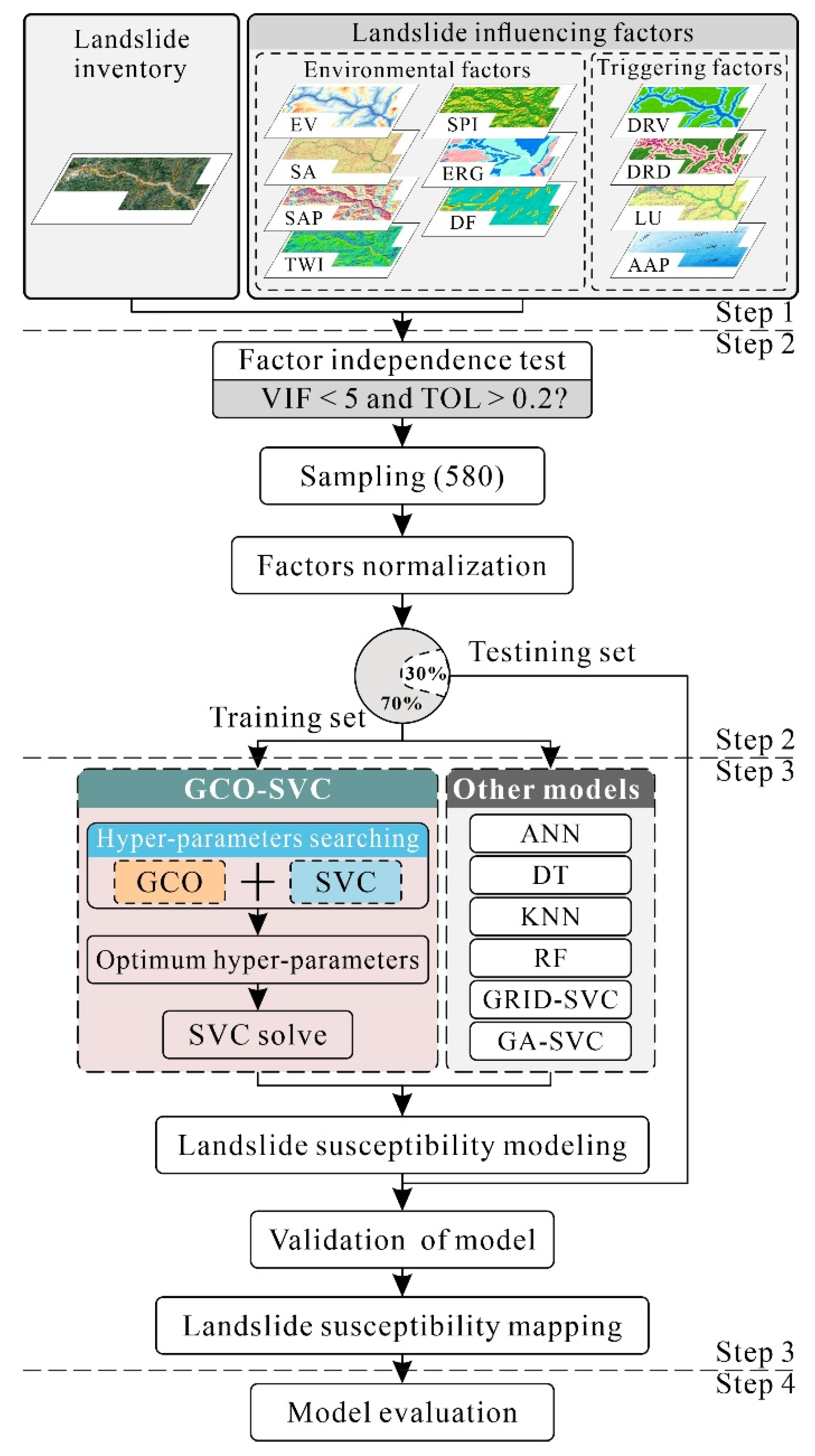
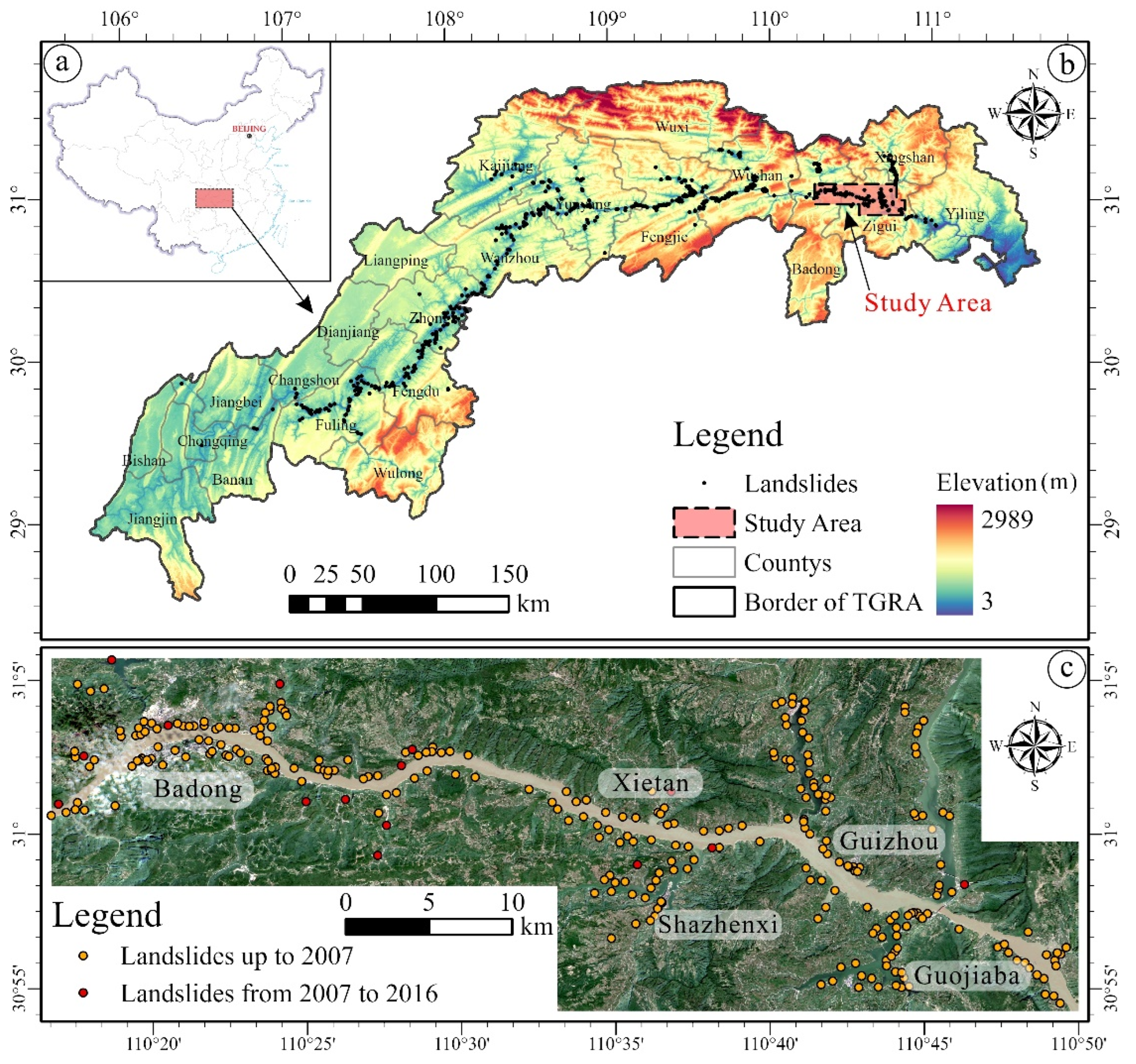
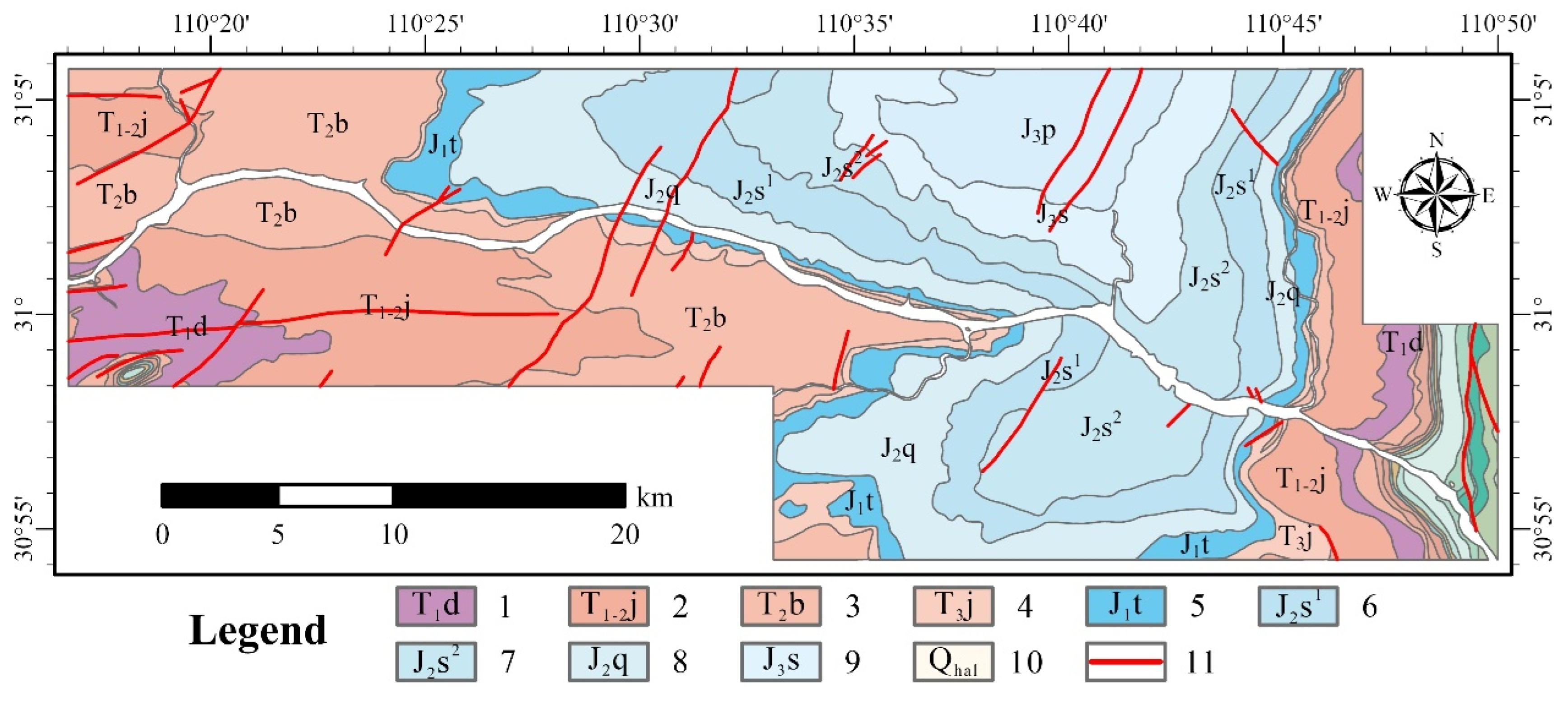
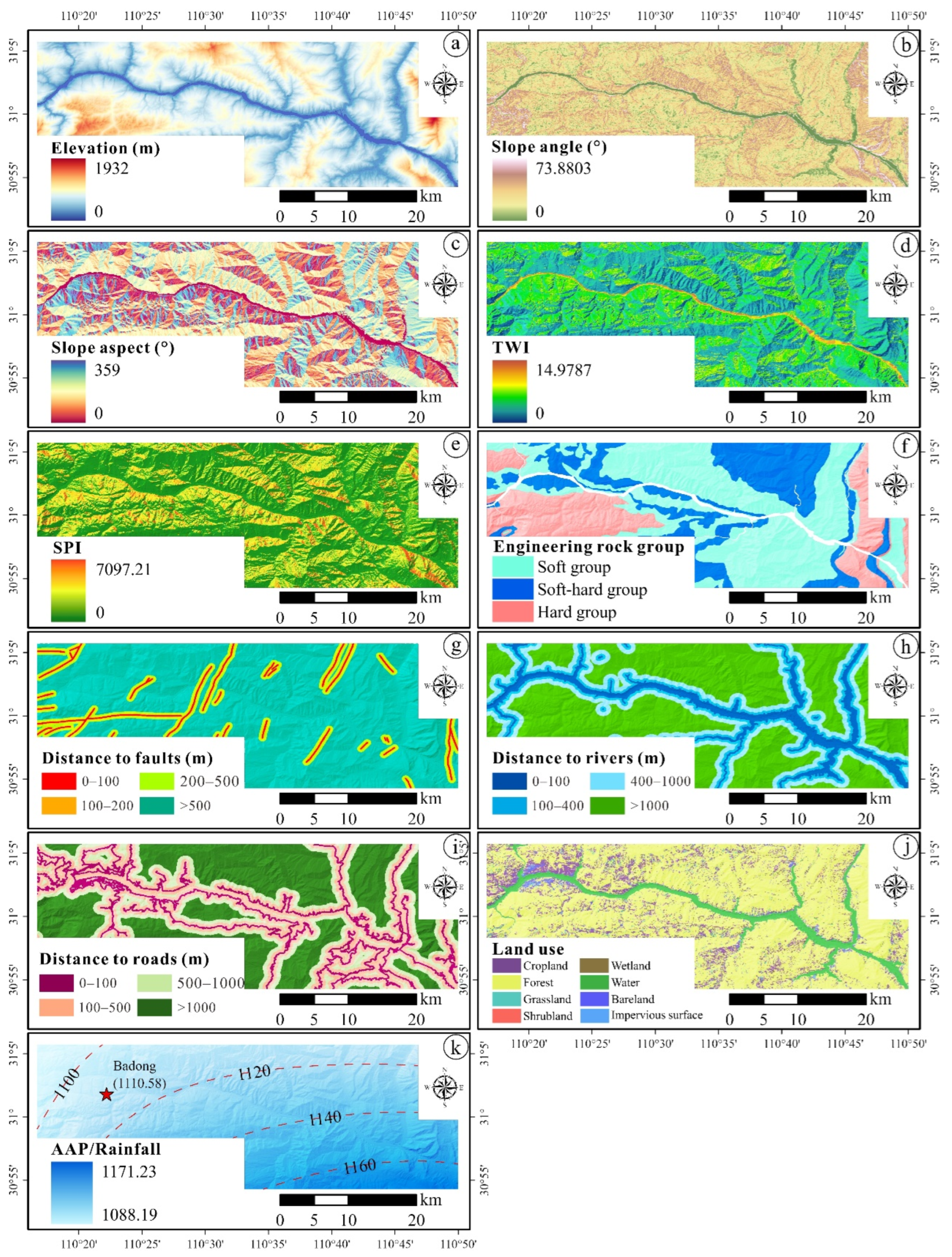
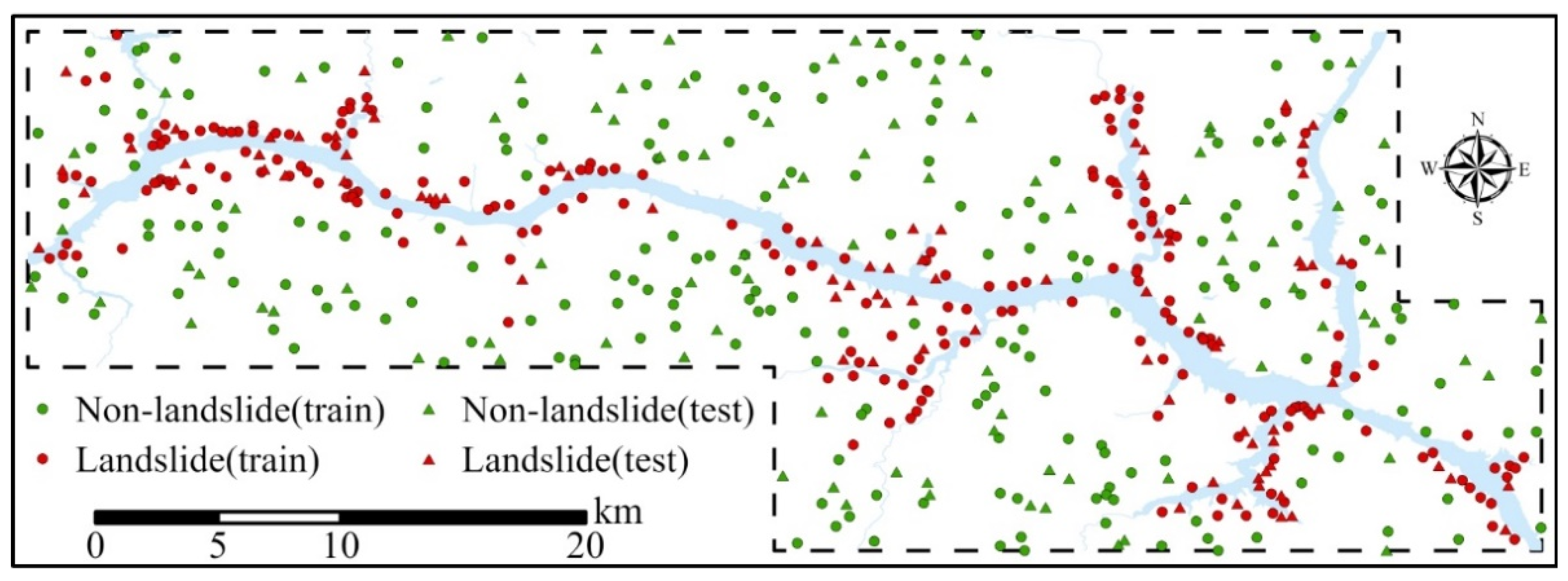


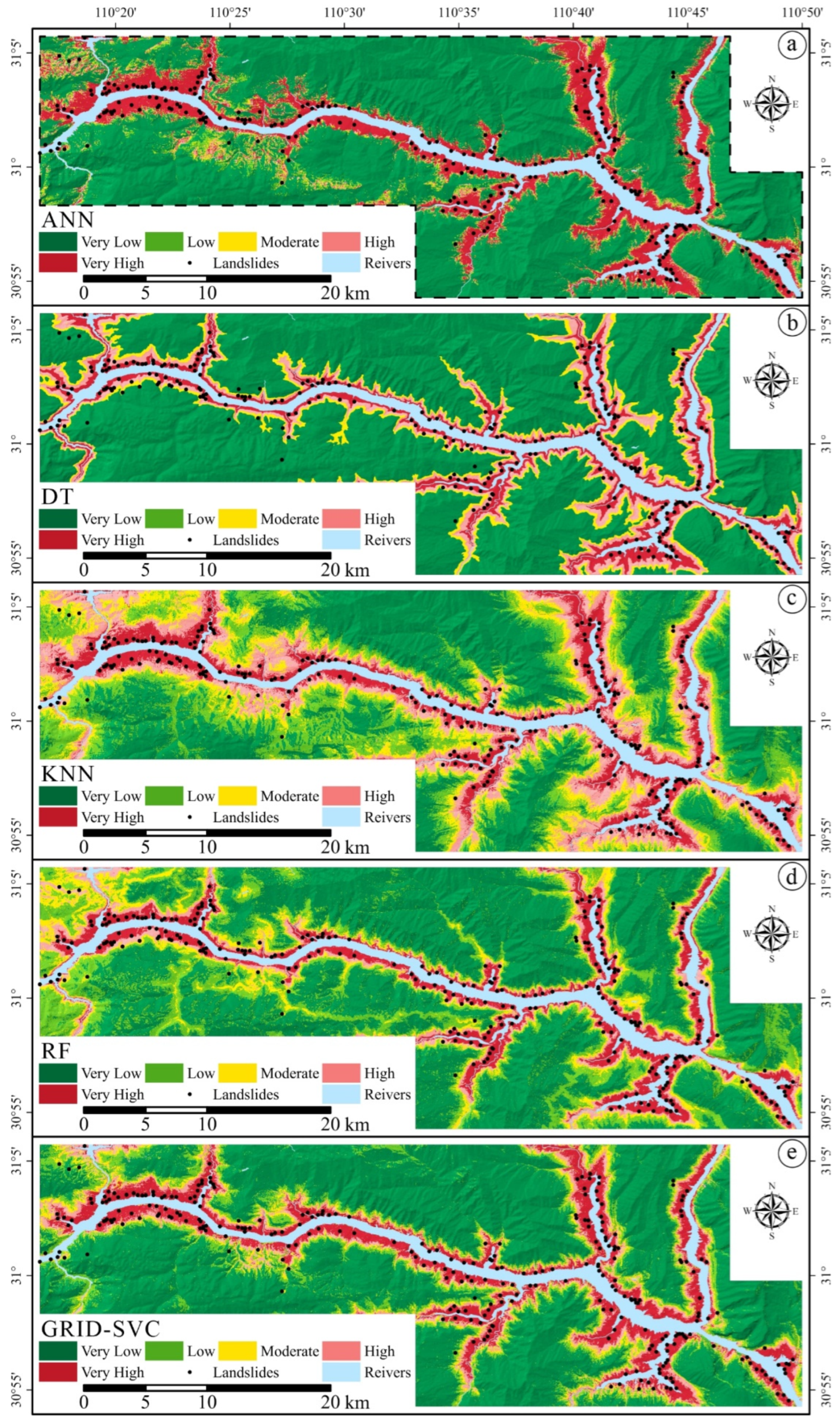
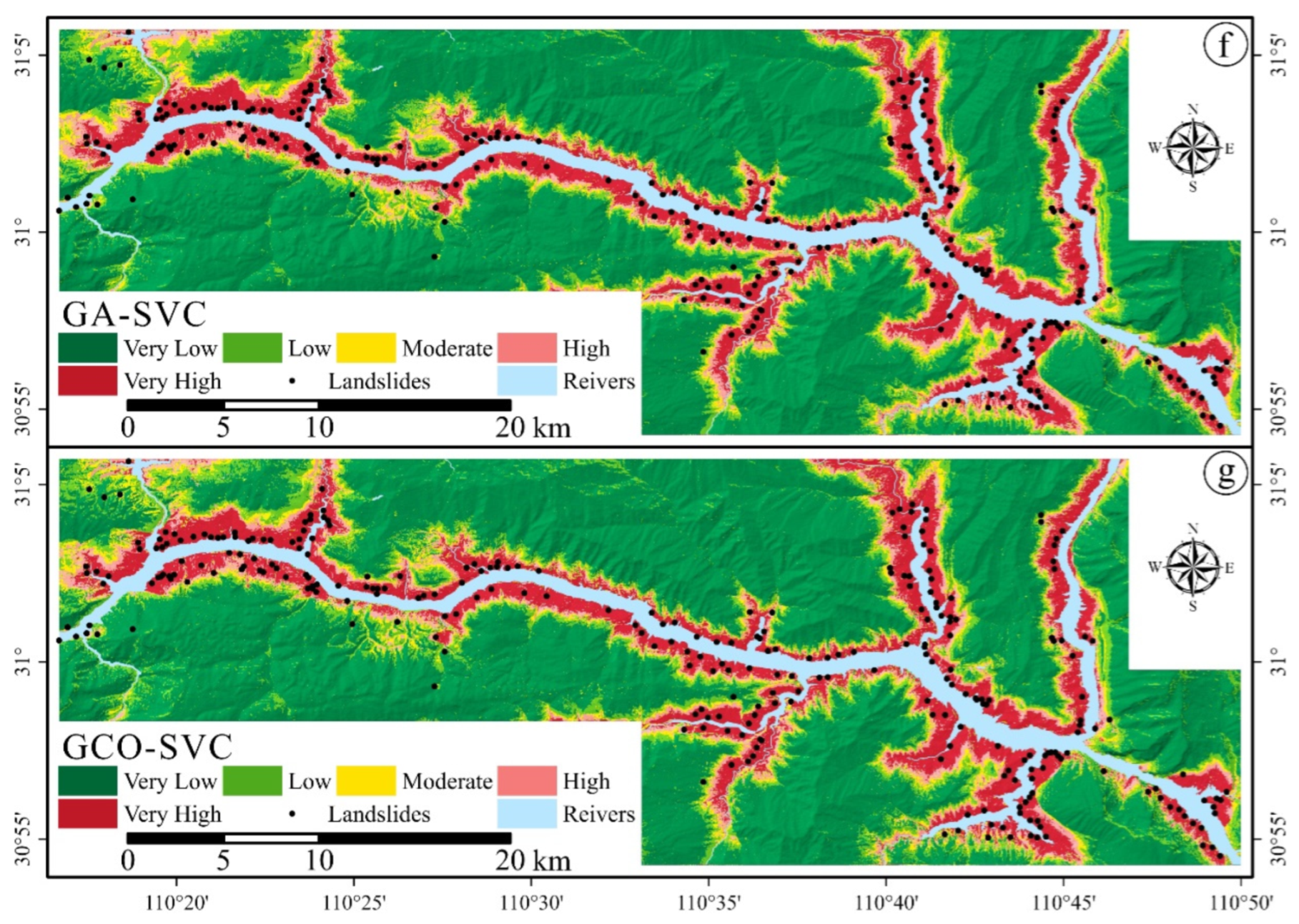
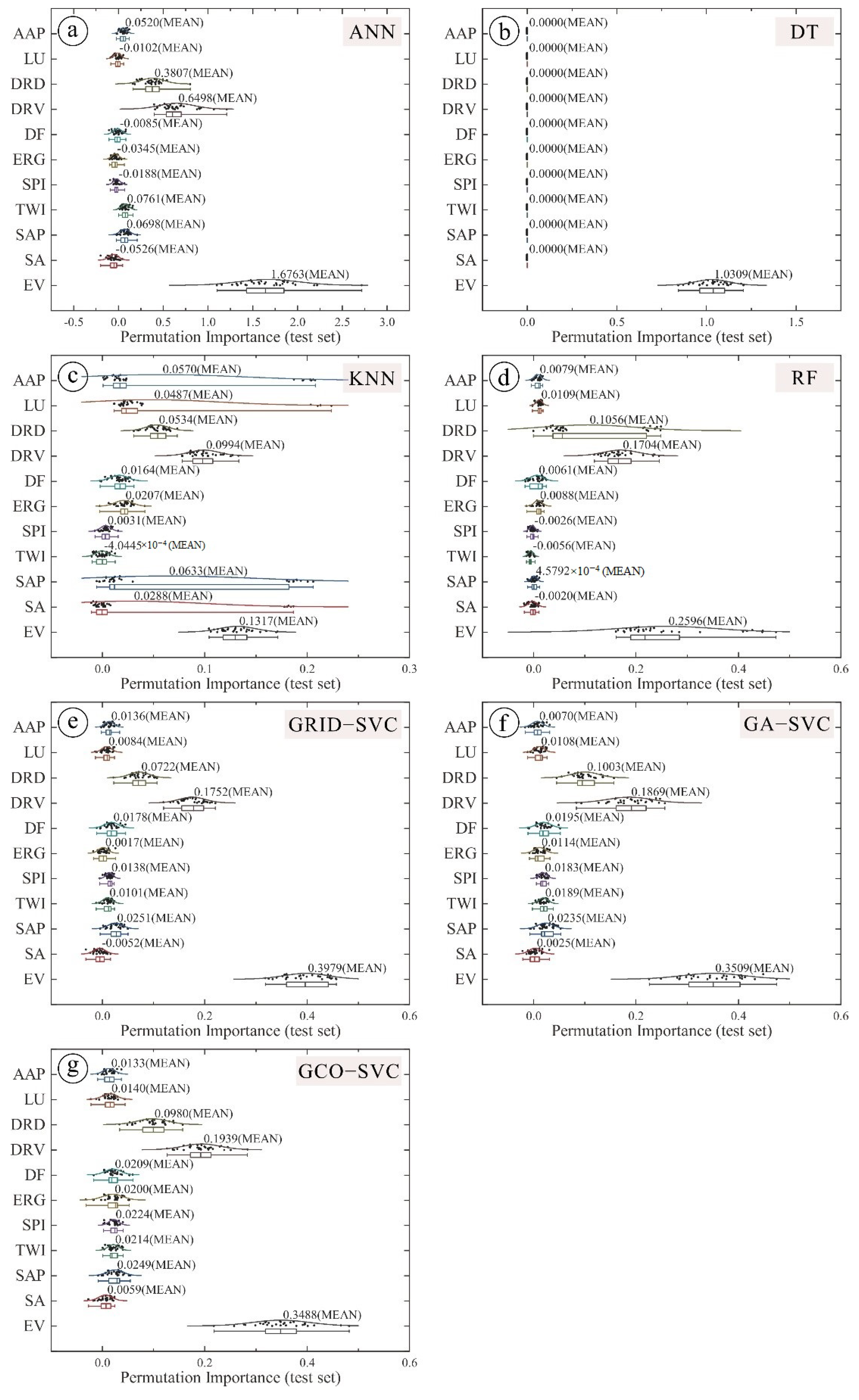
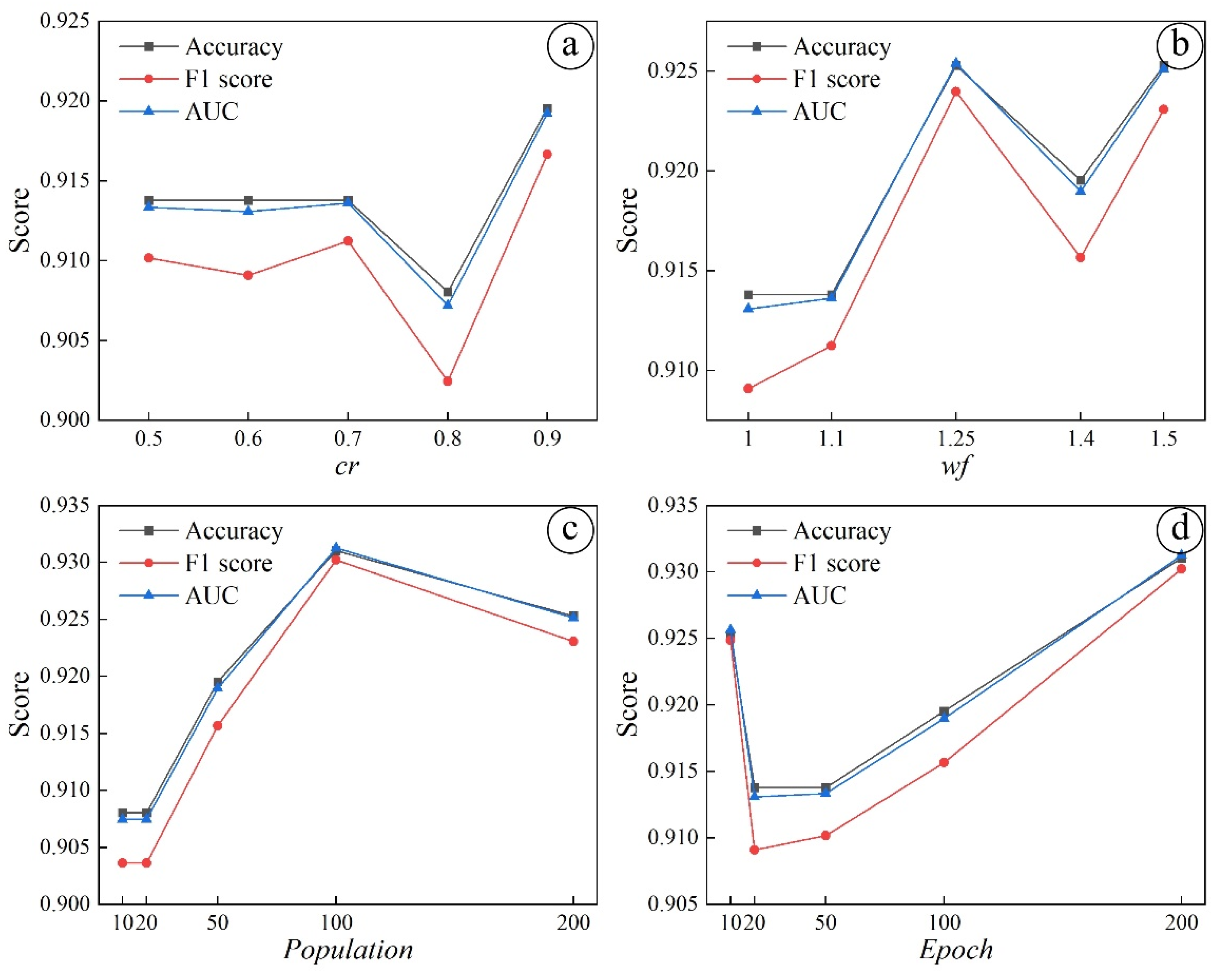
| Data Type | Date | Influencing Factors | Source |
|---|---|---|---|
| DEM (12.5 m) | 2011 | Elevation (EV) Slope angle (SA) Slope aspect (SAP) Topographic wetness index (TWI) Stream power index (SPI) | ALOS PALSAR |
| Geologic map (1:200,000) | 2013 | Engineering rock group (ERG) Distance to faults (DF) | National Geological Archives of China |
| Road network | 2021 | Distance to roads (DRD) | OpenStreetMap |
| River network | 2021 | Distance to rivers (DRV) | OpenStreetMap |
| Rainfall monitoring data | 2015–2020 | Average annual precipitation (AAP) | Hubei Provincial Hydrology and Water Resources Bureau |
| Land use (10 m) | 2017 | Land use (LU) | FROM-GLC10 [37] |
| Kernel Name | Kernel Function | Kernel Parameters |
|---|---|---|
| linear | None | |
| poly | ||
| RBF | ||
| sigmoid |
| Model | Parameters | Search Space |
|---|---|---|
| ANN | Neurons in hidden layer | |
| ) | ||
| DT | Max depth | |
| Min sample leaf | ||
| KNN | N neighbors | |
| Weight | ||
| Distance | ||
| RF | Number of estimators | |
| Criterion | ||
| GRID-SVC | Kernel | |
| C | ||
| GA-SVC | Kernel | |
| C | ||
| GCO-SVC | Kernel | |
| C | ||
| EV | SA | SAP | TWI | SPI | ERG | DF | DRD | DRV | AAP | LU | |
|---|---|---|---|---|---|---|---|---|---|---|---|
| VIF | 2.884 | 1.942 | 1.123 | 2.16 | 2.066 | 1.393 | 1.104 | 1.781 | 2.976 | 1.123 | 1.247 |
| TOL | 0.347 | 0.515 | 0.89 | 0.463 | 0.484 | 0.718 | 0.906 | 0.561 | 0.336 | 0.891 | 0.802 |
| Model | Parameter Settings | Optimal Hyperparameters | Best Score |
|---|---|---|---|
| ANN | 0.434876 | ||
| DT | 0.324234 | ||
| KNN | 0.290551 | ||
| RF | 0.238102 | ||
| GRID-SVC | 0.243250 | ||
| GA-SVC | 0.232593 | ||
| GCO-SVC | 0.231471 |
| Dataset | Metric | ANN | DT | KNN | RF | GRID-SVC | GA-SVC | GCO-SVC |
|---|---|---|---|---|---|---|---|---|
| Training | Accuracy | 1.0000 | 0.8966 | 1.0000 | 1.0000 | 0.9409 | 0.9384 | 0.9532 |
| F1 score | 1.0000 | 0.8981 | 1.0000 | 1.0000 | 0.9420 | 0.9400 | 0.9538 | |
| Log loss | 0.0000 | 3.5730 | 0.0000 | 0.0000 | 2.0417 | 2.1268 | 1.6164 | |
| AUC | 1.0000 | 0.8965 | 1.0000 | 1.0000 | 0.9408 | 0.9382 | 0.9532 | |
| Testing | Accuracy | 0.9080 | 0.8908 | 0.8966 | 0.9080 | 0.9195 | 0.9368 | 0.9425 |
| F1 score | 0.9036 | 0.8914 | 0.8989 | 0.9080 | 0.9186 | 0.9364 | 0.9412 | |
| Log loss | 3.1760 | 3.7715 | 3.5730 | 3.1760 | 2.7790 | 2.1835 | 1.9850 | |
| AUC | 0.9075 | 0.8914 | 0.8976 | 0.9085 | 0.9198 | 0.9371 | 0.9425 |
| Pairwise Comparison | Value | Value | Significance |
|---|---|---|---|
| GCO-SVC vs. ANN | 333.56 | 0.00 | Yes |
| GCO-SVC vs. DT | −160.03 | 0.00 | Yes |
| GCO-SVC vs. KNN | −515.59 | 0.00 | Yes |
| GCO-SVC vs. RF | −8.67 | 0.00 | Yes |
| GCO-SVC vs. GRID-SVC | 81.97 | 0.00 | Yes |
| GCO-SVC vs. GA-SVC | 333.79 | 0.00 | Yes |
| Model | Susceptibility Level | Pixels in Domain (A) | Pixels in Landslide (B) | Percentage of Domain to Total Domain (C) | Percentage of Landslide to Total Landslide (D) | Frequency Ratio (D/C) |
|---|---|---|---|---|---|---|
| ANN | Very Low | 1,006,570 | 3222 | 78.19% | 9.55% | 0.1221 |
| Low | 44,610 | 1058 | 3.47% | 3.13% | 0.9046 | |
| Moderate | 24,966 | 791 | 1.94% | 2.34% | 1.2084 | |
| High | 37,504 | 1655 | 2.91% | 4.90% | 1.6831 | |
| Very High | 173,619 | 27,025 | 13.49% | 80.07% | 5.9368 | |
| DT | Very Low | 1,012,900 | 4911 | 78.69% | 14.55% | 0.1849 |
| Low | 0 | 0 | 0.00% | 0.00% | 0.0000 | |
| Moderate | 73,691 | 3325 | 5.72% | 9.85% | 1.7209 | |
| High | 101,856 | 8683 | 7.91% | 25.73% | 3.2514 | |
| Very High | 98,822 | 16,832 | 7.68% | 49.87% | 6.4963 | |
| KNN | Very Low | 653,424 | 81 | 50.76% | 0.24% | 0.0047 |
| Low | 207,630 | 726 | 16.13% | 2.15% | 0.1334 | |
| Moderate | 131,899 | 1627 | 10.25% | 4.82% | 0.4705 | |
| High | 172,609 | 8254 | 13.41% | 24.46% | 1.8238 | |
| Very High | 121,707 | 23,063 | 9.45% | 68.33% | 7.2274 | |
| RF | Very Low | 819,929 | 1128 | 63.70% | 3.34% | 0.0525 |
| Low | 201,461 | 2420 | 15.65% | 7.17% | 0.4581 | |
| Moderate | 88,133 | 3010 | 6.85% | 8.92% | 1.3026 | |
| High | 75,989 | 5944 | 5.90% | 17.61% | 2.9834 | |
| Very High | 101,757 | 21,215 | 7.90% | 62.86% | 7.9517 | |
| GRID-SVC | Very Low | 900,588 | 1185 | 69.96% | 3.51% | 0.0502 |
| Low | 116,040 | 1650 | 9.01% | 4.89% | 0.5423 | |
| Moderate | 58,303 | 1809 | 4.53% | 5.36% | 1.1834 | |
| High | 79,551 | 4440 | 6.18% | 13.16% | 2.1287 | |
| Very High | 132,787 | 24,667 | 10.32% | 73.09% | 7.0851 | |
| GA-SVC | Very Low | 919,184 | 1337 | 71.41% | 3.96% | 0.0555 |
| Low | 101,455 | 1492 | 7.88% | 4.42% | 0.5609 | |
| Moderate | 53,742 | 1652 | 4.17% | 4.89% | 1.1724 | |
| High | 73,138 | 4103 | 5.68% | 12.16% | 2.1396 | |
| Very High | 139,750 | 25,167 | 10.86% | 74.57% | 6.8685 | |
| GCO-SVC | Very Low | 918,028 | 1331 | 71.32% | 3.94% | 0.0553 |
| Low | 106,417 | 1498 | 8.27% | 4.44% | 0.5369 | |
| Moderate | 51,981 | 1638 | 4.04% | 4.85% | 1.2019 | |
| High | 69,348 | 4044 | 5.39% | 11.98% | 2.2241 | |
| Very High | 141,495 | 25,240 | 10.99% | 74.78% | 6.8035 |
Publisher’s Note: MDPI stays neutral with regard to jurisdictional claims in published maps and institutional affiliations. |
© 2022 by the authors. Licensee MDPI, Basel, Switzerland. This article is an open access article distributed under the terms and conditions of the Creative Commons Attribution (CC BY) license (https://creativecommons.org/licenses/by/4.0/).
Share and Cite
Xia, D.; Tang, H.; Sun, S.; Tang, C.; Zhang, B. Landslide Susceptibility Mapping Based on the Germinal Center Optimization Algorithm and Support Vector Classification. Remote Sens. 2022, 14, 2707. https://doi.org/10.3390/rs14112707
Xia D, Tang H, Sun S, Tang C, Zhang B. Landslide Susceptibility Mapping Based on the Germinal Center Optimization Algorithm and Support Vector Classification. Remote Sensing. 2022; 14(11):2707. https://doi.org/10.3390/rs14112707
Chicago/Turabian StyleXia, Ding, Huiming Tang, Sixuan Sun, Chunyan Tang, and Bocheng Zhang. 2022. "Landslide Susceptibility Mapping Based on the Germinal Center Optimization Algorithm and Support Vector Classification" Remote Sensing 14, no. 11: 2707. https://doi.org/10.3390/rs14112707
APA StyleXia, D., Tang, H., Sun, S., Tang, C., & Zhang, B. (2022). Landslide Susceptibility Mapping Based on the Germinal Center Optimization Algorithm and Support Vector Classification. Remote Sensing, 14(11), 2707. https://doi.org/10.3390/rs14112707






